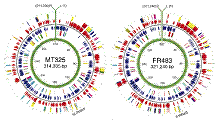Virology, Nebraska Center for
ORCID IDs
https://orcid.org/0000-0002-4681-470X
Date of this Version
9-10-2018
Citation
Viruses 2018, 10, 484; doi:10.3390/v10090484 www.mdpi.com/journal/viruses 1/19
Abstract
Plant viruses use cellular factors and resources to replicate and move. Plants respond to viral infection by several mechanisms, including innate immunity, autophagy, and gene silencing, that viruses must evade or suppress. Thus, the establishment of infection is genetically determined by the availability of host factors necessary for virus replication and movement and by the balance between plant defense and viral suppression of defense responses. Host factors may have antiviral or proviral activities. Proviral factors condition susceptibility to viruses by participating in processes essential to the virus. Here, we review current advances in the identification and characterization of host factors that condition susceptibility to plant viruses. Host factors with proviral activity have been identified for all parts of the virus infection cycle: viral RNA translation, viral replication complex formation, accumulation or activity of virus replication proteins, virus movement, and virion assembly. These factors could be targets of gene editing to engineer resistance to plant viruses.
Included in
Biological Phenomena, Cell Phenomena, and Immunity Commons, Cell and Developmental Biology Commons, Genetics and Genomics Commons, Infectious Disease Commons, Medical Immunology Commons, Medical Pathology Commons, Virology Commons


Comments
2018 by the author